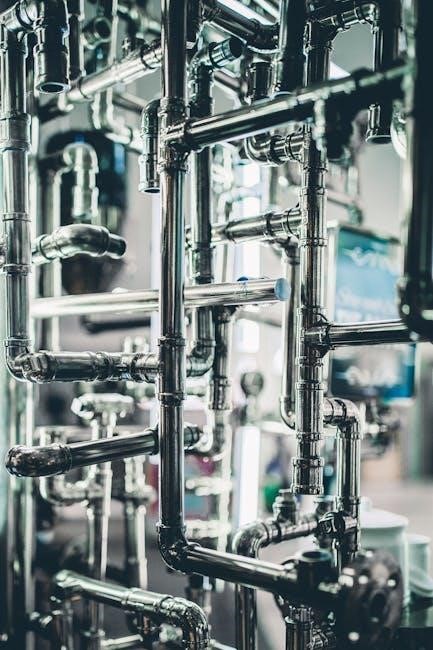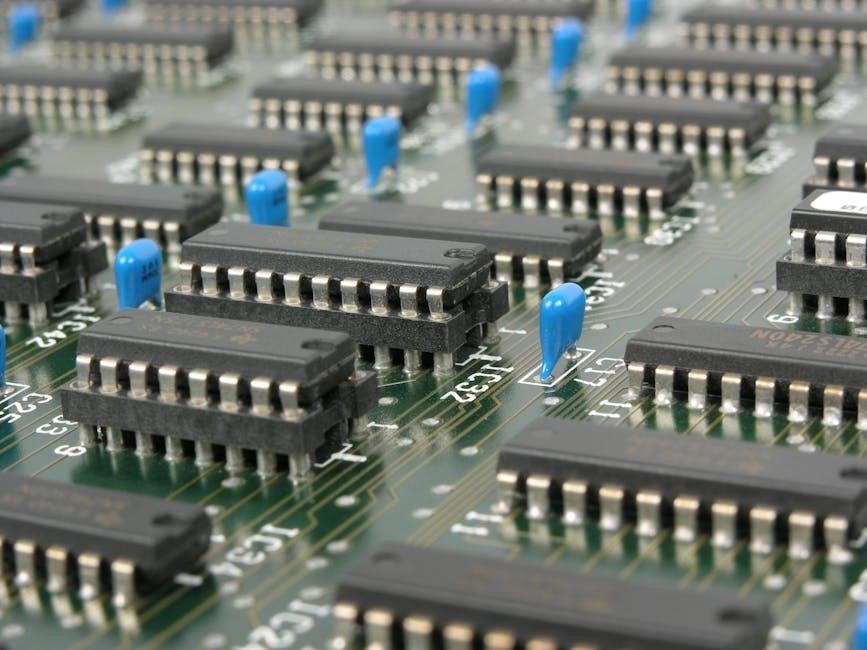The musculoskeletal system is a complex network of bones, muscles, joints, tendons, ligaments, and cartilage that provides structural support, enables movement, and protects internal organs.
1.1 Importance of the Musculoskeletal System
The musculoskeletal system is vital for enabling movement, maintaining posture, and protecting internal organs. It provides structural support, facilitates locomotion, and contributes to overall bodily functions. Its integrity directly impacts quality of life, as dysfunction can lead to mobility issues and discomfort. Proper functioning ensures effective coordination between bones, muscles, and joints, making it essential for daily activities and maintaining independence. Its role in movement and stability underscores its significance in human health and well-being.
1.2 Overview of Key Components
The musculoskeletal system comprises bones, muscles, joints, tendons, ligaments, and cartilage. Bones provide structural support and protection, while muscles enable movement through contraction. Joints facilitate articulation between bones, allowing for varied movements. Tendons and ligaments connect muscles to bones and stabilize joints, respectively. Cartilage cushions joints, reducing friction and enhancing mobility. Together, these components form a cohesive system essential for movement, stability, and overall bodily function, working harmoniously to maintain posture and enable locomotion.

Structure of the Musculoskeletal System
The musculoskeletal system is an integrated framework of bones, muscles, joints, tendons, ligaments, and cartilage, working together to provide structural support and facilitate movement.
2.1 Bones and Their Functions
Bones are rigid, calcified connective tissues forming the body’s internal framework. They provide structural support, protect vital organs, and facilitate movement by acting as levers for muscles. Bones also store minerals like calcium and phosphate, essential for overall health. Their unique composition, combining organic collagen and inorganic hydroxyapatite, ensures strength and flexibility. Bones are dynamic, undergoing continuous remodeling to adapt to stress and repair micro-fractures, maintaining the musculoskeletal system’s integrity and functionality throughout life.
2.2 Joints and Their Classification
Joints are structures that connect bones, enabling movement between body segments. They are classified into three main types: synovial, cartilaginous, and fibrous joints. Synovial joints, the most common, are characterized by a fluid-filled space between bones, allowing for significant mobility. Examples include the knees and elbows; Cartilaginous joints, like the spine, have limited movement, while fibrous joints, such as those in the skull, are immovable. This classification helps understand their functional roles and limitations in the musculoskeletal system.
2.3 Muscles: Types and Their Roles
Muscles are dynamic tissues that play a crucial role in movement, stability, and bodily functions. There are three main types: skeletal, smooth, and cardiac muscles. Skeletal muscles, attached to bones, enable voluntary movements and maintain posture. Smooth muscles, found in internal organs, control involuntary actions like digestion. Cardiac muscle, exclusive to the heart, ensures continuous blood circulation. Each type has distinct structures and functions, with skeletal muscles containing myocytes that form fibers and fascicles, enabling precise control over movement and stability in the musculoskeletal system.
2.4 Tendons, Ligaments, and Fascia
Tendons, ligaments, and fascia are essential connective tissues in the musculoskeletal system. Tendons connect muscles to bones, enabling movement by transmitting forces. Ligaments link bones, providing stability and limiting excessive joint movement. Fascia, a fibrous tissue, envelops muscles, supporting their function and facilitating smooth movement. Together, these structures enhance mobility, maintain joint integrity, and ensure proper biomechanical alignment, playing vital roles in both dynamic and static movements while preventing injury to muscles and bones.
2.5 Cartilage and Its Significance
Cartilage is a flexible, yet durable connective tissue that cushions joints, reduces friction, and absorbs shock, facilitating smooth movement. Found between bones, it prevents direct contact, minimizing wear and tear. Cartilage also supports the growth and development of bones, acting as a template during ossification. Its resilience is crucial for joint health, enabling activities like walking and running. Degeneration of cartilage, as seen in conditions like osteoarthritis, can lead to pain and reduced mobility, highlighting its vital role in musculoskeletal function and overall bodily movement.
Functions of the Musculoskeletal System
The musculoskeletal system provides structural support, enables movement, and protects internal organs. It facilitates locomotion, maintains posture, and assists in regulating body temperature, ensuring overall bodily function and mobility.
3.1 Support and Protection of the Body
The musculoskeletal system provides essential support and protection to the body. Bones form a structural framework, safeguarding vital organs like the brain, heart, and lungs. Muscles, acting as dynamic stabilizers, assist in maintaining posture and absorbing shocks, while connective tissues like ligaments and tendons reinforce joints and prevent excessive movement. This integrated system ensures the body’s stability and shields internal structures from external forces, enabling optimal functioning and movement.
3.2 Facilitating Movement and Locomotion
The musculoskeletal system enables movement and locomotion by functioning as a coordinated biomechanical unit. Bones act as levers, while joints provide points of motion. Muscles contract to pull on tendons, which transmit forces to bones, creating movement. Ligaments stabilize joints, ensuring proper alignment during motion. This integrated system allows for a wide range of activities, from walking and running to fine motor tasks. Its adaptability ensures efficient movement, tailored to the body’s needs and environmental demands.
3.3 Role in Maintaining Body Temperature
The musculoskeletal system contributes to thermoregulation through muscle activity. Shivering, a rapid muscle contraction, generates heat, aiding in cold environments. Additionally, the system’s metabolic processes release energy, which helps maintain core temperature. This function is crucial for overall bodily homeostasis, ensuring optimal operating conditions for cellular activities and maintaining balance between heat production and loss, vital for survival and bodily functions.

Interaction with the Nervous System
The musculoskeletal system interacts with the nervous system through neural control of muscles, enabling voluntary movements and maintaining posture and balance via proprioception and sensory feedback mechanisms.
4.1 Neural Control of Muscular Movements
The nervous system regulates muscular movements through a complex network of motor neurons and feedback mechanisms. Skeletal muscles are controlled by the somatic nervous system, which transmits signals from the brain to muscle fibers, enabling precise and voluntary movements. Proprioceptors in muscles and tendons provide sensory feedback, ensuring accurate control and coordination of movements. This neural-muscular interaction is essential for maintaining posture, balance, and executing complex motor tasks efficiently.
4.2 Proprioception and Body Awareness
Proprioception is the ability to sense the position and movement of body parts, crucial for balance, posture, and coordinated movements. Specialized receptors in muscles, tendons, and joints detect changes in tension and length, sending signals to the brain. This feedback loop enables precise adjustments in movement and maintains body awareness. Proprioception is essential for motor learning, preventing injuries, and ensuring smooth, efficient physical activities. It integrates with neural control to optimize overall musculoskeletal function and responsiveness.

Common Pathologies of the Musculoskeletal System
The musculoskeletal system is prone to conditions like osteoarthritis, tendinitis, fractures, muscle strains, and osteoporosis, impacting mobility and quality of life significantly.
5.1 Osteoporosis and Fractures
Osteoporosis is a condition characterized by weakened bones, increasing fracture risk. It often results from hormonal changes, calcium/vitamin D deficiency, or age-related bone density loss. Fractures, especially in the hips and spine, are common complications. Symptoms may include back pain, height loss, or stooped posture. Early diagnosis via bone density scans is crucial. Treatment options include bisphosphonates, lifestyle modifications, and physical therapy to strengthen bones and prevent further fractures, improving quality of life for affected individuals.
5.2 Muscle Injuries and Strains
Muscle injuries and strains occur due to overstretching or tearing of muscle fibers. Symptoms include pain, swelling, and limited mobility. These injuries are common in athletes but can also result from sudden movements or repetitive strain. Treatment involves rest, ice, compression, and physical therapy. Severe cases may require medical intervention. Prevention strategies include proper warm-ups, stretching, and strength training to enhance muscle resilience and reduce injury risk, ensuring optimal recovery and maintaining muscle function for daily activities and sports performance.
5.3 Joint Disorders: Arthritis and Beyond
Joint disorders, such as arthritis, tendinitis, and bursitis, disrupt joint health, causing pain, inflammation, and limited mobility. Osteoarthritis, the most common type, results from cartilage degeneration, while rheumatoid arthritis is an autoimmune condition. Symptoms include stiffness, swelling, and reduced range of motion. Early diagnosis and treatment, including physical therapy and medication, are crucial. Untreated joint disorders can impair daily activities and quality of life, emphasizing the importance of prompt medical intervention to manage symptoms and prevent progression.

Diagnostic and Therapeutic Procedures
Diagnostic techniques like X-rays, MRIs, and CT scans help identify musculoskeletal issues. Therapeutic approaches include physical therapy, injections, and shockwave therapy to restore function and alleviate pain.
6.1 Imaging Techniques for Musculoskeletal Assessment
Imaging techniques like X-rays, MRIs, CT scans, and ultrasound are essential for diagnosing musculoskeletal disorders. These tools provide detailed visuals of bones, joints, and soft tissues, aiding in identifying fractures, inflammation, or degenerative conditions. Advanced imaging helps guide therapeutic interventions and monitor recovery progress, ensuring accurate treatment plans for various musculoskeletal pathologies.
6.2 Rehabilitation and Physical Therapy
Rehabilitation and physical therapy play a crucial role in restoring musculoskeletal function after injuries or surgeries. Customized exercise programs, manual therapy, and modalities like heat or cold therapy are commonly used. These interventions aim to improve mobility, strength, and flexibility while reducing pain. Physical therapists also educate patients on proper ergonomics and exercises to prevent future injuries, promoting long-term musculoskeletal health and functional independence.

Maintaining Musculoskeletal Health
Regular exercise, proper ergonomics, and a balanced diet are essential for maintaining musculoskeletal health, preventing injuries, and ensuring optimal bodily function and mobility throughout life.
7.1 Exercise and Physical Activity
Regular exercise is crucial for maintaining musculoskeletal health. It strengthens muscles, enhances bone density, and improves joint mobility. Weight-bearing activities, such as walking or jogging, promote bone health, while resistance training builds muscle mass; Aerobic exercises improve circulation, delivering nutrients to tissues. Flexibility exercises, like yoga, reduce stiffness and enhance range of motion. Consistent physical activity helps prevent injuries, supports posture, and maintains mobility, ensuring optimal musculoskeletal function throughout life. A balanced regimen is key to long-term health and injury prevention.
7.2 Ergonomics and Posture
Proper ergonomics and posture are essential for musculoskeletal health. Ergonomic adjustments in the workplace minimize strain on muscles and joints, reducing injury risks. Maintaining correct posture during sitting, standing, and lifting prevents muscle imbalances and spinal misalignment. Awareness of body positioning and regular breaks can alleviate discomfort. Implementing ergonomic practices, such as using supportive furniture and tools, promotes long-term musculoskeletal well-being and enhances overall productivity. Correct posture and ergonomics are vital for preventing chronic pain and maintaining optimal body alignment.

Recent Advances in Musculoskeletal Research
Recent advancements include radiomics for early disease detection and shockwave therapy for injury recovery. These innovations enhance diagnostic accuracy and treatment efficacy, improving patient outcomes significantly.
8.1 Radiomics and Its Applications
Radiomics is an emerging field that extracts quantitative features from medical imaging to analyze tissue characteristics. In musculoskeletal research, it aids in early detection of conditions like osteoporosis and joint degeneration. By analyzing MRI and CT scans, radiomics identifies subtle patterns, enabling precise diagnostics and monitoring. This technology, combined with machine learning, enhances predictive analytics for personalized treatment plans, improving patient outcomes significantly.
8.2 Shockwave Therapy for Injuries
Shockwave therapy is a non-invasive treatment using high-energy sound waves to stimulate healing in injured tissues. It is commonly used for conditions like tendinitis and muscle strains. The therapy enhances blood flow, reduces inflammation, and promotes tissue repair. Studies show it accelerates recovery and reduces pain without surgical intervention. Widely used in physical therapy and sports medicine, shockwave therapy offers a promising approach for musculoskeletal injuries, improving mobility and restoring function effectively.
Educational Resources and References
Educational resources include PDF guides on musculoskeletal anatomy, diagnostics, and therapies. Authors like EE Achkasov and M Pleshkov provide in-depth reviews and practical applications.
9.1 Recommended Literature and PDF Guides
Various PDF guides and literature are available, offering insights into musculoskeletal anatomy, diagnostics, and therapies. Works by authors like EE Achkasov and M Pleshkov provide detailed reviews on shockwave therapy and radiomics. NY Krutikova focuses on musculoskeletal pathologies in adolescents. These resources are essential for understanding the system’s structure, function, and common disorders, making them valuable for both students and professionals seeking comprehensive knowledge.

